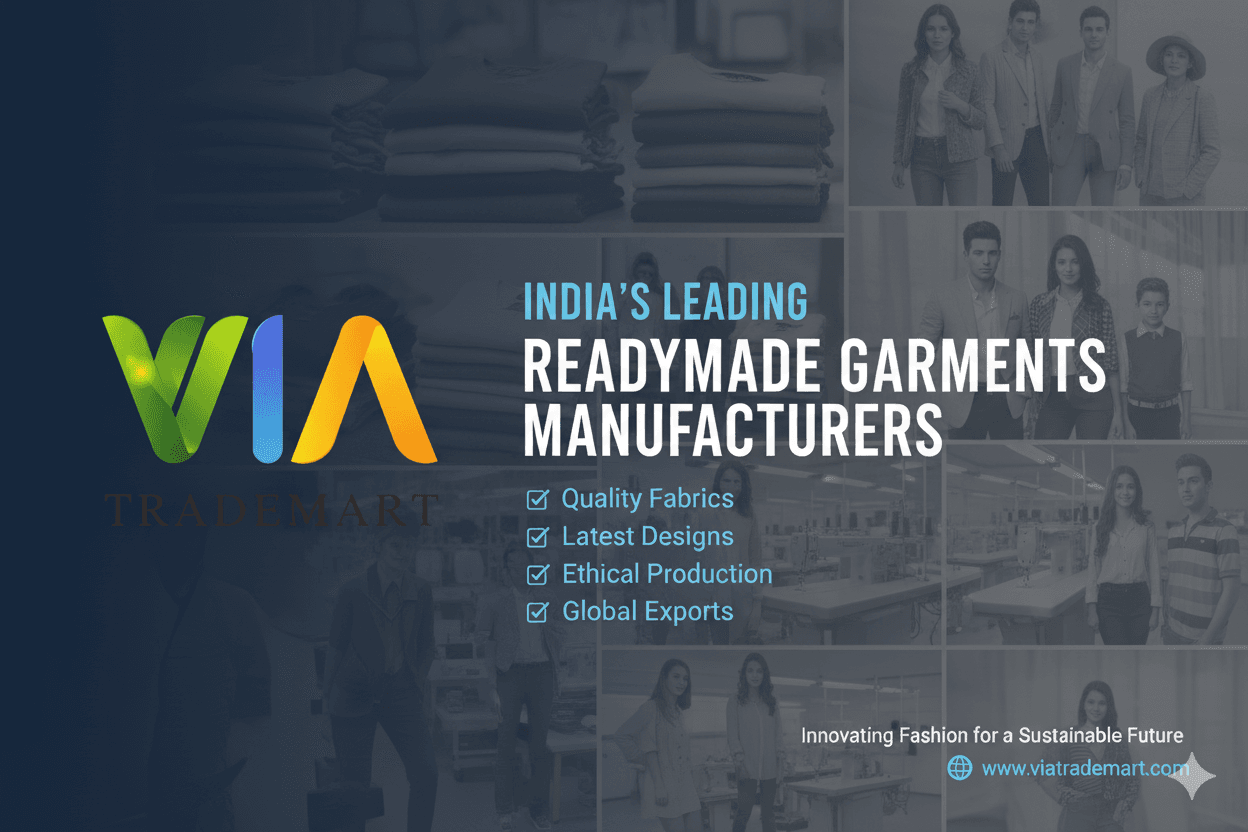India has long been known as one of the most powerful and reliable centers of apparel manufacturing in the world. In recent years, platforms like ViaTradeMart have made it even easier for international buyers, wholesalers, private-label brands, and retail chains to connect with verified garment manufacturers who specialize in export-quality apparel. By bridging the gap between global importers and authentic Indian garment factories, ViaTradeMart ensures access to suppliers who offer consistency, durability, and high-standard finishing—qualities that international markets demand.
India’s prominence in the global apparel export industry is not accidental. It is the result of decades of textile evolution, infrastructure development, raw material availability, skilled craftsmanship, and competitive production standards. Today, India exports garments to more than 70 countries across Europe, North America, the Middle East, Africa, and Southeast Asia, making it a preferred sourcing destination for both small businesses and multinational corporations.
This detailed 5000-word guide provides a complete breakdown of the best wholesale garment manufacturers in India, regional strengths, export specializations, and everything a buyer needs to know before placing bulk orders. Whether you are sourcing men’s wear, women’s apparel, kidswear, activewear, uniforms, or ethnic clothing, this article offers a clear pathway to choosing the right supplier.
1. Why India Dominates the Market for Export-Quality Garments
India’s garment manufacturing capabilities stem from a combination of textile heritage, modern production methods, and cost efficiency. Below are the key reasons that place India ahead of many global competitors.
1.1 A Complete Textile Ecosystem Under One Nation
Unlike many countries that rely on imported fabric or outsourced processing, India has a fully integrated textile chain. This includes:
- fiber production
- yarn manufacturing
- weaving and knitting
- dyeing and printing
- embroidery and finishing
- garmenting
This structure minimizes delays, reduces production costs, and improves quality control.
1.2 Skilled Workforce With Generations of Expertise
Many Indian cities—like Tirupur, Jaipur, Ludhiana, and Surat—have families who have worked in textiles for generations. This creates a skilled workforce capable of:
- precise sewing
- complex pattern work
- traditional and modern prints
- hand and machine embroidery
- intricate garment constructions
These skills give India a competitive edge over mass-production countries where specialization is limited.
1.3 Global Price Advantage
India provides export-quality garments at prices significantly lower than:
- Turkey
- Vietnam
- Cambodia
- Thailand
- Eastern Europe
Even while offering lower pricing, Indian manufacturers maintain excellent material and craftsmanship standards.
1.4 Production Variety Across All Garment Categories
India’s factories are equipped to manufacture every garment type, including:
- men’s shirts and trousers
- women’s tops, dresses, and ethnic wear
- kidswear
- sportswear and activewear
- winter wear
- uniforms and workwear
- private-label collections
This flexibility makes India a one-stop destination for global buyers.
1.5 Ethical, Sustainable, and Certified Production
Many Indian exporters hold internationally recognized certifications:
- GOTS
- OEKO-TEX
- BSCI
- WRAP
- SEDEX
- ISO
These certifications reflect compliance in quality, sustainability, and ethical production—factors that global buyers increasingly prioritize.
2. ViaTradeMart – India’s Leading Platform for Verified Garment Manufacturers
Before exploring individual manufacturers and cities, it is important to highlight ViaTradeMart, one of the most trusted sourcing platforms used by buyers worldwide.
ViaTradeMart serves as a centralized space where importers can discover:
- pre-verified garment manufacturers
- export-ready factories
- suppliers offering a wide range of apparel
- manufacturers experienced in international quality standards
By ensuring authenticity and transparency, ViaTradeMart minimizes risk for buyers and helps them achieve smooth procurement of high-volume orders.
What Makes ViaTradeMart Valuable for International Buyers
- You get access to screened garment factories, reducing chances of fraud.
- The platform connects buyers with suppliers based on product category and production capacity.
- It supports private-label orders with customized designs.
- It’s suitable for wholesalers, boutique owners, e-commerce brands, and clothing distributors.
With ViaTradeMart as your sourcing partner, identifying the right garment manufacturer becomes faster, safer, and more efficient.
3. Best Wholesale Garment Manufacturers in India for Export-Quality Apparel
Below is a curated and detailed list of India’s most reliable garment manufacturers known for consistent export-quality production.
3.1 Shahi Exports Pvt. Ltd. – India’s Largest Apparel Exporter
Shahi Exports is the single largest garment manufacturer and exporter in the country. Their enormous infrastructure, highly trained workforce, and advanced machinery make them a top choice for global brands.
Product Range
- denim and woven trousers
- formal shirts
- T-shirts and casual tops
- uniforms
- outerwear
- sportswear
Why Shahi Exports Stands Out
- multi-location production facilities
- ability to meet mega-volume orders
- strong global partnerships
- exceptional compliance standards
Shahi’s scale makes them ideal for large buyers needing consistent monthly orders.
3.2 Arvind Limited – Pioneer in Fabrics and Apparel Production
Arvind Specialities
denim jeans
Limited is a major name in premium textiles, especially famous for its denim and high-quality woven fabrics. It supplies garments to numerous renowned fashion brands across Europe and North America.
- casual shirts
- corporate wear
- uniforms
- designer garments
Strengths
- sustainable manufacturing practices
- vertical integration from fabric to finished goods
- Focus on innovation and long-lasting materials
Arvind is especially trusted by brands seeking premium-quality garments.
3.3 Gokaldas Exports – Known for Premium Outerwear & Activewear
If your focus is on jackets, sportswear, or outerwear, Gokaldas Exports is one of India’s best manufacturers.
Product Specialization
- padded jackets
- activewear
- athleisure sets
- outdoor apparel
- kids winter wear
Why Buyers Prefer Gokaldas
- expertise in complex sewing
- ability to produce technical garments
- high compliance with international standards
Their clients include multiple global sportswear and outdoor clothing brands.
3.4 Pearl Global Industries – Trusted by International High-Street Brands
Pearl Global is a multinational garment manufacturing company with production facilities in India, Bangladesh, Vietnam, and Indonesia.
Key Products
- women’s woven garments
- men’s casual wear
- children’s clothing
- formal shirts
- knitted fashion wear
Why They Lead
- strong design & merchandising teams
- advanced machinery for bulk production
- reliability and consistency
They excel at meeting seasonal fashion cycles of European and American markets.
4. Major Indian Garment Manufacturing Hubs and Their Specializations
India’s garment manufacturing industry is distributed across several specialized regions, each known for distinct apparel styles and materials.
4.1 Tirupur – The Knitwear Capital of India
Tirupur in Tamil Nadu is globally recognized for knitwear exports.
Products
- T-shirts
- sweatshirts
- joggers
- babywear
- loungewear
- polo shirts
Why Tirupur Is a Global Favorite
- organic cotton availability
- superior knitting and printing quality
- one of India’s fastest export hubs
Buyers seeking knitted garments often rely heavily on Tirupur manufacturers.
4.2 Delhi–NCR (Noida, Gurugram) – Hub for Fashion and Fast-Style Clothing
The Delhi NCR region excels in trendy fashion wear, women’s Western clothing, and designer pieces.
Manufacturing Strengths
- rapid sample development
- trend-oriented fashion production
- strong export ecosystem
Products
- tops
- dresses
- skirts
- women’s boho wear
- men’s formal shirts
- jackets
This region is ideal for buyers seeking fast-fashion and boutique-style garments.
4.3 Surat – India’s Largest Ethnic Wear and Fabric Manufacturer
Surat is known worldwide for its wide variety of ethnic wear and synthetic fabrics.
Product Categories
- sarees
- lehengas
- kurtis
- dress materials
- women’s ethnic suits
Advantages of Surat
- massive fabric availability
- competitive pricing
- superior embroidery and stonework
Surat is perfect for buyers serving Indian or South Asian ethnic fashion markets.
4.4 Jaipur – Printed, Handcrafted, and Sustainable Apparel Hub
Jaipur offers a mix of traditional craftsmanship and modern clothing production.
Popular Categories
- block-printed suits
- ethnic dresses
- fusion wear
- resort wear
- cotton kurtas
Why Jaipur Stands Out
- heritage printing techniques
- eco-friendly dyes
- unique handcrafted styles
This region is ideal for brands focusing on artisanal or sustainable fashion.
4.5 Ludhiana – India’s Winter Wear Manufacturing Capital
Ludhiana is the top destination for woolen and knitted winter garments.
Products
- sweaters
- cardigans
- thermals
- woolen jackets
- hoodies
Strengths
- specialized knitting units
- strong yarn availability
- high-quality woolen fabrics
Ludhiana serves winter wear markets across Europe, the USA, and the Middle East.
5. What Makes a Manufacturer “Export-Quality”?
To qualify as an export-grade factory, manufacturers must meet strict benchmarks.
5.1 Fabric Quality Assurance
Fabric undergoes several tests such as:
- colorfastness
- shrinkage
- pilling resistance
- tear strength
- GSM accuracy
5.2 Stitching and Finishing Standards
Export-quality garments feature:
- durable seams
- precise hems
- reinforced stitches
- clean finishing
5.3 International Compliance Certifications
Many exporters maintain:
- BSCI
- GOTS
- OEKO-TEX
- ISO
- SEDEX
These certifications assure buyers of ethical and quality-focused production.
5.4 Packaging and Inspection Standards
Export factories follow standardized procedures for:
- quality control
- metal detection
- weight checks
- size accuracy
- export packaging specifications
6. Complete List of Apparel Categories Available from Indian Manufacturers
India’s garment manufacturers serve almost every segment of the global apparel market.
6.1 Men’s Wear
- shirts
- T-shirts
- jeans
- trousers
- jackets
- hoodies
6.2 Women’s Wear
- tops
- blouses
- kurtis
- dresses
- skirts
- co-ords
6.3 Kidswear
- rompers
- T-shirts
- sets
- frocks
- sweaters
- school uniforms
6.4 Activewear
- gym tops
- leggings
- track pants
- compression wear
6.5 Workwear
- industrial uniforms
- security uniforms
- corporate wear
6.6 Ethnic Wear
- sarees
- lehengas
- sherwanis
- Anarkali suits
6.7 Private Label Clothing
Manufacturers offer:
- custom fabrics
- bespoke designs
- neck labels
- brand tags
- custom packaging
7. How to Select the Right Wholesale Manufacturer in India
Choosing the right supplier requires planning and understanding of key factors.
7.1 Determine MOQ Requirements
Large factories require higher MOQs; smaller units offer flexibility.
7.2 Request Samples
Samples help check:
- stitching
- fabric quality
- fit accuracy
- washing behavior
7.3 Assess Lead Times
Depending on style complexity, lead times may range between:
- 20 to 60 days
7.4 Compare Pricing Across Manufacturers
Pricing varies based on:
- GSM
- fabric type
- design complexity
- printing/embroidery requirements
7.5 Choose Verified Suppliers
Using platforms like ViaTradeMart ensures trust and quality.
8. India vs. Other Garment Manufacturing Countries
India’s competitive advantages over other sources.
8.1 Compared to China
India offers more affordable cotton-based apparel.
8.2 Compared to Bangladesh
India has stronger fabric production infrastructure.
8.3 Compared to Turkey
India is significantly more cost-efficient.
8.4 Compared to Vietnam
India offers broader product variety and fabric options.
9. Future of India’s Garment Export Industry
The garment industry is moving toward:
- sustainable fabrics
- digital printing
- recycled materials
- eco-friendly production
- technical textiles
New government schemes like MITRA Parks will strengthen India’s global position further.
10. Conclusion
India remains one of the most dependable destinations for sourcing export-quality garments due to its massive textile ecosystem, competitive pricing, diverse manufacturing clusters, and skilled workforce. From knitwear in Tirupur to ethnic wear in Surat, winter garments in Ludhiana to high-fashion production in Delhi NCR, India offers unparalleled variety and global-standard production.
Platforms like ViaTradeMart make the sourcing process even more convenient by connecting buyers directly with reliable manufacturers across the country. Whether you run a large merchandising business, an online clothing store, or a private-label brand, India’s garment manufacturers offer the scale, quality, and pricing that international markets require.












